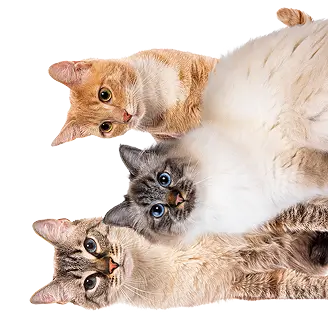Cymric
Other name: Longhair Manx

The Cymric is basically a long-haired Manx. They share all the same physical and genetic characteristics, except for their coats. Although the long-haired variety of this tailless cat may have originally appeared naturally on the Isle of Man, some Canadian breeders have claimed the breed, arguing that they worked on creating their characteristics intentionally. The debate still rages on, so the Cymric is not currently recognised as an individual breed by some cat associations.
|
Life expectancy |
The {breedName} has a life expectancy of approximately 15 years |
|
Temperament |
|
|
Adult size |
Female
Between 12 and 14 in
Male
Between 12 and 14 in
|
|
Adult weight |
Female
Between 7 and 11 lb
Male
Between 9 and 11 lb
|
|
Coat colour
Black / seal, blue / grey-slate/ cinnamon / cinnamon, fawn / fawn, red, white, |
Black White Red Blue |
|
Type of coat
Mid-length |
Long |
|
Eye colour
Any colour |
Blue
Green
Yellow
Brown
|
Due to their lack of a tail, this breed requires special attention when handling. Pushing, or pressing on the point where the tail should be can cause a Cymric pain. Similarly, you must support their hind legs when lifting them to avoid tension in their spine. However, this skilful jumper will always remain balanced as their tails do not affect their ability to balance.
More details about the Cymric
Cymric: Origins and history
The word Cymric comes from the Welsh name for Wales (Cymru). Yet, the tailless cat is not Welsh. It comes from the Isle of Man, a tiny island between Ireland and England. The first few small cats arrived there by boat very early in the history of the island. Some of these cats were short-haired, but others were long-haired. When the Manx gene spread, it is likely that some of the first members of the Manx breed, if not long haired themselves, were most likely carriers of the recessive long haired gene.
However, it took a long time for the Cymric be officially recognised as a breed. In fact, some Canadian breeders claim to be responsible for its creation. While there may be some truth to this claim, it is not fully accepted. The various cat associations still do not agree on the classification of this breed’s status. Cymric are more rare than their shorter-haired counterparts!
Physical characteristics of the Cymric
The Cymric is a little round ball - from the shape of their eyes to the curvature of their backs, their rounded heads, and obviously accentuated by their lack of a tail - every single part of their body is round. Their hind legs are also significantly longer than their front ones, which gives them an excellent jumping ability. Their fur is composed of a dense undercoat and a mid-length outer coat.
Their lack of a tail is characteristic of the breed, but only some Cymrics are anurous (tailless). There are 4 subtypes, depending on their length of tail:
- The Rumpy: No caudal nor sacral vertebrae and thus the Rumpy has no tail at all! There is a small groove where a tail would normally be found.
- The Riser (or Rumpy-Riser): 1 to 3 sacral vertebrae and a small "bump" of cartilage where the tail normally is normally found.
- The Stumpy: 1 to 3 caudal vertebrae which give the Stumpy a short tail.
- The Longy: long, sometimes even totally normal tail.
Cymric: Characteristics
Cymric: Behaviour
Breed compatibility Cymric
Cymric: Purchase price
Depending on their lineage, type, age etc. the cost will vary. Unfortunately due to the rarety of the cat, we do not have enough data to set an average price for a Cymric.
It also costs around £25/month to keep them in good health.
Cymric: Shedding
Average
The Longhair Manx loses an average amount of hair.
Cymric: Grooming
Although daily brushing is recommended, their grooming remains quite easy. However, when they are moulting, you may have to double your brushing efforts!
Cymric: Health
Perhaps because they mature slowly, they can sometimes surpass records in terms of their longevity, on average reaching 15 years of age.
Surprisingly tough, they’re a relative sturdy and healthy breed. However they can suffer from Manx Syndrome.
The Cymric has a genetic predisposition towards being overweight.
- Manx Syndrome: when the mutated gene shortens the spine too much, severe abnormalities appear in the spine and spinal cord, such as spina bifida, but also in the bladder, intestines and hind legs ... Manx that suffer from this disease have significantly shortened life expectancies (5 years maximum).
- Megacolon: With this disease, the colon is no longer able to contract to eliminate stool, and therefore the cat loses the ability to defecate. It can be part of Manx Syndrome.
- Corneal dystrophy: eye malformation
- The Cymric can also develop the same diseases as other non-pedigree cats.
- They are also susceptible to dental diseases (gingivitis and tartar). Dental care is recommended.
The Manx gene (M), is a dominant gene, and thus expresses itself as soon as it is present. However, all tailless cats have only one mutated gene, with their other allele coding for a full length tail (m). Thus they are [Mm]. When the mutated gene is completely absent [mm], their tail is simply normal. On the other hand, an [MM] kitten will have so many changes to their spine and spinal cord that they will not survive. The gene is therefore lethal, which makes raising the breed rather difficult.
When breeding Manx cats, it is important to never couple two Rumpys, because the risk of having kittens with Manx Syndrome is very high (30% risk).
Cymrics can breed with other Cymrics, Manx, British Shorthairs and British Longhairs.

